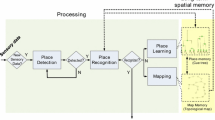Abstract
In this paper we present an example of incremental build up of a topological map to be used by a mobile robot which is programmed for navigation tasks. For this purpose we will use the concept of virtual expansion of the receptive field and invariant properties of the centre of areas in a region of open space around the robot. Then we propose, as basic elements in the buildingof this map, polygons of open space detected around the robot and referred to centres of area. The data structure that underlies our map is a graph where each node contains an open space polygon and where each arc represents the connectivity between these polygons.
Access this chapter
Tax calculation will be finalised at checkout
Purchases are for personal use only
Preview
Unable to display preview. Download preview PDF.
Similar content being viewed by others
References
José Ramón álvarez Sánchez, Félix de la Paz López, and José Mira Mira. On Virtual Sensory Coding: An Analytical Model of Endogenous Representation. In José Mira Mira and Juan V. Sánchez-Andrés, editors, Engineering Aplications of Bio-Inspired Artificial Neural Networks, volume 2 of Lecture Notes in Computer Science, pages 526–539. International Work-Conference on Artificial and Natural Neural Networks, Springer-Verlag, June 1999.
José Ramón álvarez Sánchez, Félix de la Paz López, and José Mira Mira. Mode-based Robot Navigation using Virtual Expansion of the Receptive Field. to appear in “Robotica” Special Issue on Sensorial Robotics, 2001.
Rodney A. Brooks. A Robust Layered Control System for a Mobile Robot. IEEE Transactions of Robotics and Automation, RA2(1):14–23, March 1986.
Maja J. Mataric. Behavior-Based Control: Main Properties and Implications. 1993.
N.J. Nilsson. Shakey the robot. Technical Note 323, AI Center, SRI International, 333 Ravenswood Ave., Menlo Park, CA 94025, April 1984.
Juan Romo Escansany, Félix de la Paz López, and José Mira Mira. Incremental Building of a Model of Environment in the Context of McCulloch-Craik’s Functional Architecture for Mobile Robots. In ángel Pasqual del Pobil, José Mira Mira, and Moonis Ali, editors, Task and Methods in Applied Artificial Intelligence, volume 2 of Lecture Notes in Artificial intelligence, pages 338–352. IEA-98-AIE, Springer-Verlag, June 1998.
Author information
Authors and Affiliations
Editor information
Editors and Affiliations
Rights and permissions
Copyright information
© 2001 Springer-Verlag Berlin Heidelberg
About this paper
Cite this paper
de la Paz López, F., álvarez-Sánchez, J.R. (2001). Topological Maps for Robot’s Navigation: A Conceptual Approach. In: Mira, J., Prieto, A. (eds) Bio-Inspired Applications of Connectionism. IWANN 2001. Lecture Notes in Computer Science, vol 2085. Springer, Berlin, Heidelberg. https://doi.org/10.1007/3-540-45723-2_55
Download citation
DOI: https://doi.org/10.1007/3-540-45723-2_55
Published:
Publisher Name: Springer, Berlin, Heidelberg
Print ISBN: 978-3-540-42237-2
Online ISBN: 978-3-540-45723-7
eBook Packages: Springer Book Archive




